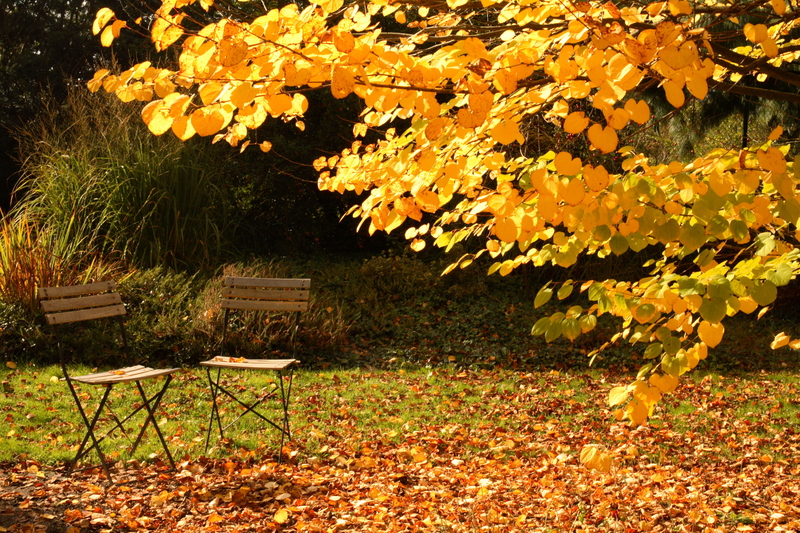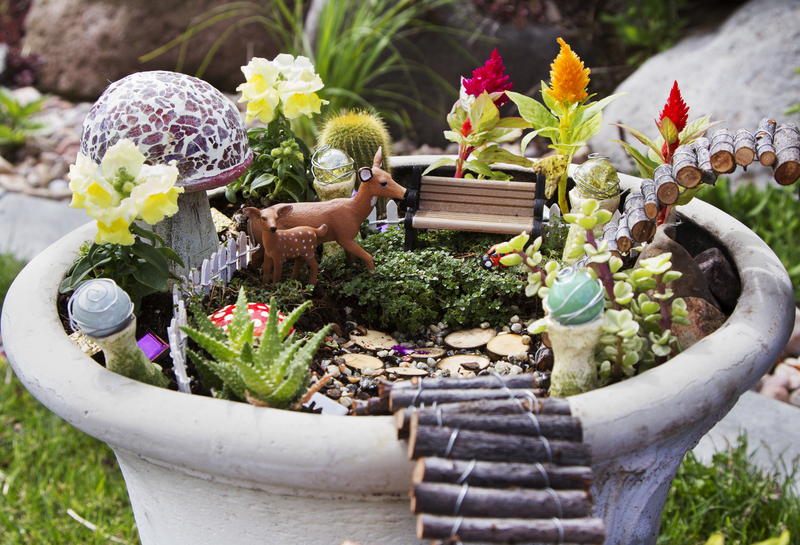How to Cultivate Imagination in Your Outdoor Space
Posted on 14/06/2025
How to Cultivate Imagination in Your Outdoor Space
Unlocking creativity outside can transform your garden, patio, or balcony into an inspiring haven. Whether you have a sprawling backyard or a small nook, understanding how to cultivate imagination in your outdoor space benefits mental health, family bonds, and personal growth. This comprehensive guide explores creative ideas and actionable steps for nurturing imagination right outside your door.

Why Fostering Imagination Outdoors Matters
Imagination is a powerful skill, essential for problem-solving, innovation, and emotional well-being. While indoor play and creativity are valuable, outdoor spaces offer unique opportunities to stimulate the senses and spark new ideas. Nature's textures, colors, sounds, and even the unpredictable weather invite exploration, risk-taking, and unstructured play for all ages.
Here's why cultivating creativity outdoors is important:
- Boosts Cognitive Development: Fresh air and natural settings enhance neural connections and critical thinking.
- Encourages Physical Movement: Running, climbing, and digging all stimulate both the body and mind.
- Reduces Stress: Spending time outside lessens anxiety and invigorates the imagination.
- Fosters Family and Community Bonds: Shared creative projects unite people of all ages.
Understanding Your Outdoor Space
Before designing for creativity, spend time observing and understanding the area you have -- no matter its size or current condition. Ask yourself:
- How much direct sunlight does it get?
- Are there existing plants, trees, or structures?
- What sounds, sights, and smells can you notice?
- Who will use this space? Children, adults, pets, guests?
By evaluating these aspects, you'll be able to cultivate creativity in your outdoor area with intention and coherence.
Creative Themes for Outdoor Spaces
Injecting a theme can instantly invite imagination. Consider these popular, imaginative concepts:
- Secret Garden: Incorporate winding paths, overgrown greenery, and hidden nooks for discovery.
- Fairy Tale Forest: String up twinkling lights, install miniature doors, and create mushroom seat clusters.
- Adventure Playground: Use outdoor-safe materials to craft obstacle courses, climbing walls, or zip lines.
- Outdoor Art Studio: Shelter a corner with a canopy, easel, or chalkboard wall for messy creativity.
- Wildlife Sanctuary: Add bird baths, bug hotels, and pollinator plants to spark curiosity about nature.
Designing for Imagination: Features and Elements
Flexible Play Zones
Zone your outdoor area for varied activities. If possible, include:
- Quiet Corners: A hammock under a tree, a reading shed, or a bench nestled in shrubbery for solitude and contemplation.
- Active Spaces: Open lawns, sand pits, or climbing structures for movement and physical play.
- Messy Play Areas: Water tables, potion-making kitchens, or mud corners where getting dirty is encouraged.
Natural Materials and Textures
Imaginative environments often use organic materials and varied textures. Try to include:
- Bark, pebbles, tree stumps, or logs for building and exploring.
- Native plants, edible herbs, or flowers that invite sensory experiences.
- Loose parts -- rocks, shells, leaves, pinecones -- for open-ended creativity.
Spaces for Storytelling and Performance
Set up a small outdoor stage or amphitheater for dramatic play. Drape outdoor-safe fabric for a curtain and gather tree stumps as "audience" seats. Encourage kids and adults alike to write and perform their own imaginative stories.
Incorporating Water and Sound
Water features--be it a birdbath, fountain, or a simple DIY stream--captivate all ages. Add windchimes, rustling grasses, or music walls (with hanging pots and pans) for multi-sensory inspiration.
Outdoor Art Installations
Encourage self-expression by dedicating a wall, fence, or old easel to rotating murals, chalk masterpieces, or mosaic tiles. Even simple hand-painted rocks can become a gallery.
Activities That Spark Imagination Outdoors
Nature-Based Crafts
- Build fairy houses from twigs and bark.
- Create leaf rubbings or flower petal art.
- Craft wind-catchers or mobiles from found objects.
Story Hunts and Scavenger Games
Invent stories about objects and creatures you find outdoors. Or design scavenger hunts that include both physical tasks (like hopping on one foot to the oak tree) and creative ones ("Draw a picture of the insect you spot").
Outdoor Science Experiments
- Grow a sunflower maze or mini vegetable garden.
- Set up a weather observation station.
- Make natural dyes from petals and berries.
Artistic Exploration
- Sketch plants and wildlife in a nature journal.
- Try landscape photography or "found object" sculptures.
- Host a family or neighborhood outdoor painting competition.
Magical Evenings
- Hang string lights or lanterns for enchanting nighttime play.
- Host storytime or open-air theater under the stars.
- Roast marshmallows and tell tall tales around a fire pit (where safe and allowed).
Plants that Fuel Outdoor Creativity
Some plants especially encourage imaginative play and discovery. Consider growing:
- Sunflowers: Create tunnels or forts with tall, fast-growing sunflowers.
- Sensory Herbs: Lavender, mint, rosemary, and basil offer touchable leaves and fragrant scents.
- Edible Berries: Strawberries or raspberries invite foraging adventures.
- Wild Grasses: Tall and feathery grasses become instant "jungles."
Bonus Tip: Designate space for kids or family members to choose *their own* plants and tend them each season, personalizing the environment and encouraging stewardship.
Year-Round Ideas for Imaginative Outdoor Spaces
Imagination outdoors shouldn't be limited to warm months! Here's how to keep creativity alive throughout the year:
Spring:
- Build hideouts from budding branches or garden debris.
- Plant seeds and chart their growth in a family science log.
- Organize a "mud kitchen" for messy cooking play on rainy days.
Summer:
- Create water walls or slip-and-slide adventures for hands-on fun.
- Host nature-inspired art workshops.
- Set up an outdoor tent for reading or dream journaling.
Autumn:
- Craft with fallen leaves, conkers, and pinecones.
- Design scavenger hunts with seasonal clues.
- Build a bug hotel for overwintering critters.
Winter:
- Paint snow or frost with food coloring in spray bottles.
- Construct ice lanterns or snow sculptures.
- Bundle up for stargazing sessions and tell cosmic stories.
Inclusive, Accessible Creativity
Cultivating imagination in your outdoor space is possible for all ages and abilities. Consider these universal design principles:
- Include wheelchair-accessible paths and sensory plants that can be experienced at varying heights.
- Offer flat, stable surfaces for art or science stations.
- Install adaptive play equipment if needed.
- Choose bright colors and fragrant, textural plants for those with differing sensory needs.
Eco-Friendly Approaches to Imaginative Outdoor Design
Imagination and sustainability go hand-in-hand when you use recycled materials, native plantings, and low-impact design. Try to:
- Repurpose old wood, bricks, or pallets for play equipment or garden beds.
- Choose drought-resistant, native plants for low-maintenance, eco-friendly beauty.
- Create wildlife habitats from logs, stones, and wildflower patches.
- Use rain barrels or grey water to supply playful water features sustainably.
Inspiring Your Family (or Yourself) to Use the Space
Sometimes, the key to nurturing imagination outside is simply an invitation. Try these approaches:
- Regularly rotate outdoor toys, art supplies, and loose parts to keep things fresh.
- Set a family "outdoor challenge of the week," such as inventing a new game or building a fort.
- Host themed garden parties or storytelling nights to celebrate the changes in the space and the seasons.

Common Mistakes (and How to Avoid Them)
Even well-meaning attempts to promote creativity in outdoor areas sometimes miss the mark. Watch out for:
- Over-structuring: Leave room for unplanned play and evolution. Not every corner needs a predetermined "purpose."
- Too much plastic: Natural, sensory-rich materials foster deeper imaginative experiences than single-use plastics.
- Lack of accessibility: Remember everyone's comfort, mobility, and sensory needs.
- Ignoring maintenance: Choose durable materials and low-maintenance plants so the space remains inviting, not overwhelming.
Conclusion: Unlocking the Magic of Your Outdoor Space
Reimagining your garden, patio, or yard as a canvas for creativity benefits children, adults, and even the natural world. By incorporating flexible play areas, sensory-rich elements, and sustainable design, you can cultivate imagination in your outdoor space all year long.
Ready to get started? Whether you begin with a single fairy house, a patch of sunflowers, or a family mural wall, the key is to invite curiosity, experimentation, and joy. In doing so, you create not just a beautiful garden -- but an oasis for dreams, connection, and lifelong creative growth.
Share your own tips, success stories, or imaginative outdoor projects in the comments below. Let's grow creative outdoor spaces together!



